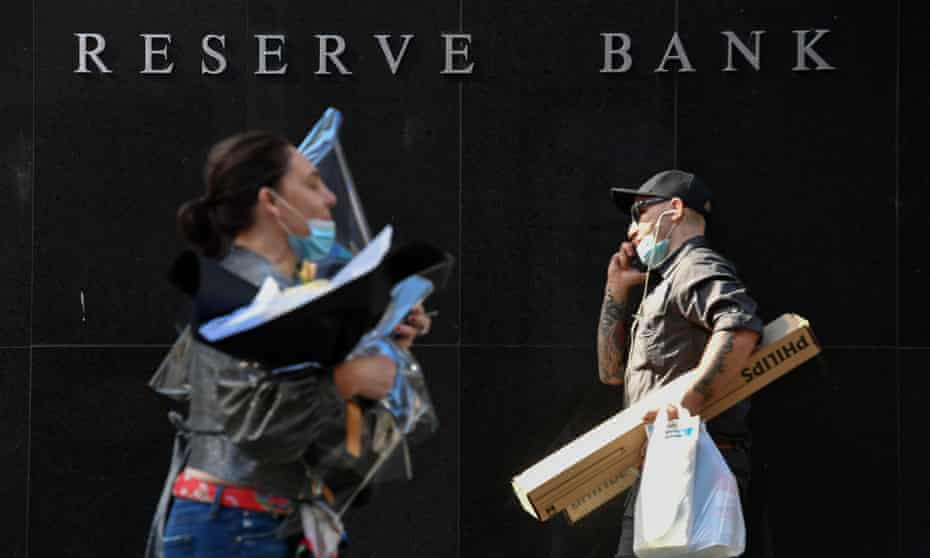Rising house prices and a resurgent economy could nudge the
Reserve Bank to raise rates for first time in 11 years
Download the free Guardian app; get our morning email briefing

Ultra-low interest rates have fuelled rocketing house prices in Australia but that could be about to change. Photograph: georgeclerk/Getty Images
Borrowers are rushing to lock in low interest rates amid gathering expectations Australia’s central bank will declare an end to its record low cash rate earlier than its current prediction of 2024.
Economists say the Reserve Bank of Australia has little choice but to revise its rate rise timing given mounting evidence the economy is recovering quickly from the lengthy Covid-triggered lockdowns in NSW, Victoria and the ACT.
It’s one year since the RBA lowered its official rate to just 0.1% and today’s board meeting is under pressure to state when it expects to raise it. No increase is imminent – and it’s now 11 years since the last rate rise – but markets are anticipating the bank will bring forward the timing of that move.
Inflation in Australia might be on the rise, but it’s hardly running wild

“If they don’t go with a date, then my fear would be that the market will interpret that as a signal they could move as soon as early next year,” David Plank, ANZ’s head of Australian economics, said.
At stake is the fate of interest rates for those with mortgages but also those seeking to enter a market where house prices continue to rise at an annual rate of more than 20%, new figures out today show.
The RBA hasn’t raised rates since November 2010. Bank economists are tipping the increase will come towards the end of 2022 or into 2023, although the market is anticipating as many as four rises – or a full percentage point increase – in 2022.
Analysts such as NAB’s chief economist Alan Oster dismiss the likelihood of rate rises next year as “garbage”, but they can point to a range of indicators of a reviving economy and the prospect of rising wages and prices to follow.
The core consumer price index for the September quarter released last week came in at 2.1%, creeping into the RBA’s preferred 2-3% inflation band for the first time since early 2016.
Job ads in ANZ’s survey, out Monday, rose 6.2% in October, returning to a level reached in June prior to the lockdowns caused by Delta Covid outbreaks. In NSW alone, new job ads last month leapt 17%.
Sign up to receive an email with the top stories from guardian Australia every morning
Plank said the speed of recovery in the jobs market suggests a rethink about unemployment. Since so many people had stopped looking for work, the true jobless rate was assumed to be much higher than the official rate of 4.6%.
“One of the reasons participation [in the job market] dropped was that a lot of people that got laid off got told by their employer ‘you’ve got a job back with us as soon as we reopen’,” he said. “So they didn’t bother searching because they knew they had a job.”
The ultra-low interest rates have fuelled rocketing house prices although there is evidence the propellant is losing some of its force. One is that modestly tighter lending controls kicked in from today but also because borrowing costs are starting to tick higher.
Still, Australia’s house prices rose another 1.5% in October according to researchers CoreLogic in data out today. The advance was in line with the September rise, and left prices 21.6% higher than for a year earlier.
Among the capitals, Sydney’s house prices added 1.5% for the month, while Melbourne’s gain was just under 1%. Brisbane led the advance with a 2.5% rise in October but Perth notched its first negative monthly result since June, dropping 0.1%.
“Housing prices continue to outpace wages by a ratio of about 12:1,” CoreLogic’s research director Tim Lawless said. “This is one of the reasons why first-homebuyers are becoming a progressively smaller component of housing demand.”
Rents, meanwhile, were up 0.7% for the month, up from a pace of 0.6% in September, according to the figures, which are not seasonally adjusted.
New borrowing commitments for housing totalled $30.3b in September, according to Bureau of Statistics data out on Monday that were adjusted to take into account seasonal changes. That figure, though down 1.4% from the previous month, remains 35.5% higher than a year earlier.
Historically, about 85% of mortgages have been at variable rates and the rest at fixed ones. During the plunge in borrowing costs after Covid’s first wave, that ratio has shifted to about 50-50 as borrowers flock to secure the lower interest rates, Plank said.

Inflation is back in the news – so should Australians be worried?
As loans typically take three months or so to come through, borrowers are already seeing market rates starting to rise. That is one factor curbing future house price rises, NAB’s Oster said.
“You are probably going to mainly see [a slowing in the growth rate] by about early next year, and you might see house prices flattish from the middle of the year,” he said. So that means only a 5% increase or so in 2022 compared with about 25% this year.
The rapid changes in the market are adding to the challenges faced by the RBA to steady the economic ship. GDP dropped at annual rate of about 3.5% in the September quarter and will probably rise about 3% in the final three months of 2021, Oster said.
“So you’re going to have this sort of massive fall,” he said. “But then you get a big bounce because people are now believing that lockdowns are gone, particularly in New South Wales and Victoria.”


